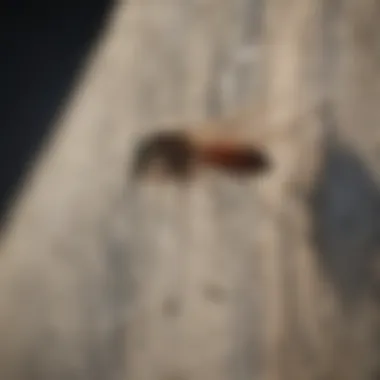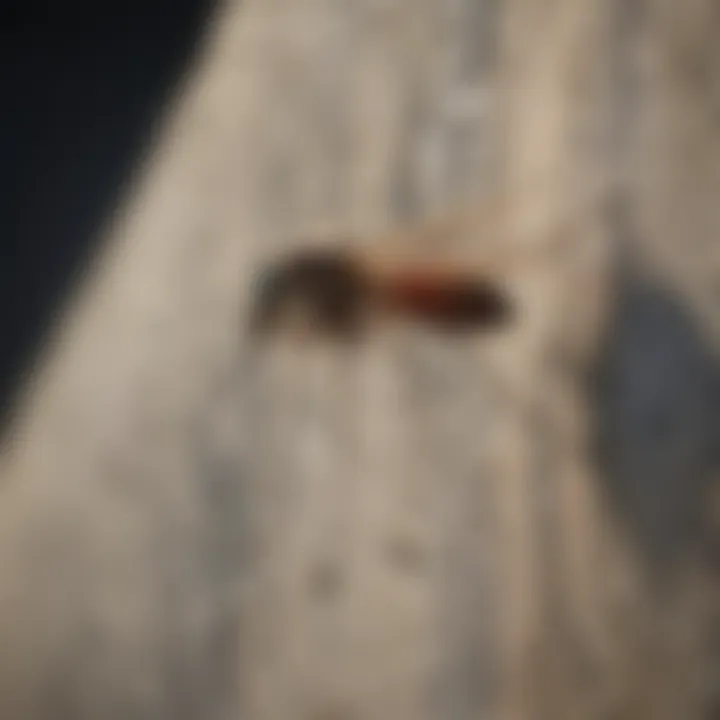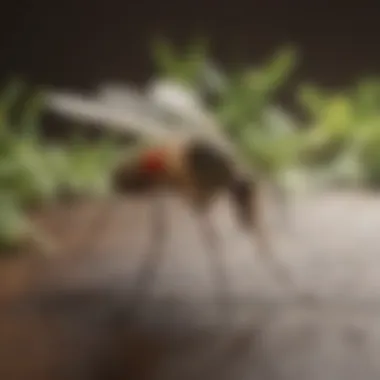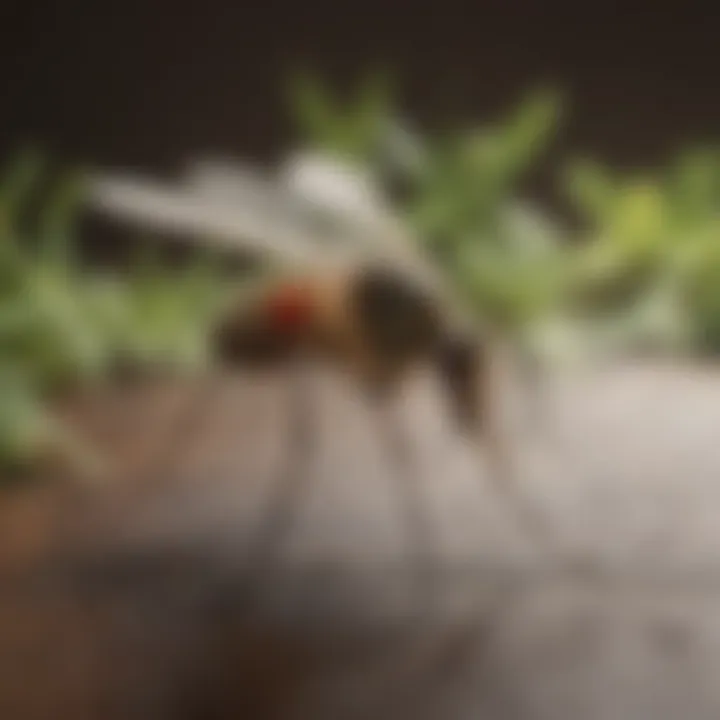Addressing Mosquito Issues in Homes: Insights & Solutions


Intro
Mosquitoes present a persistent challenge within residential environments. They densely populate settings where stagnant water is available, and their presence often leads to health risks and discomfort among residents. This article aims to delve into the reasons behind mosquito prevalence in homes and how homeowners can effectively manage this issue. By understanding the pest itself, we can employ better prevention techniques and explore eco-friendly pest control methods to reclaim our living spaces.
Understanding Pests
Definition of Pests
Mosquitoes are categorized as pests due to their potential to transmit diseases and create a nuisance in human habitats. These insects reproduce quickly, particularly in warm and humid climates. The female mosquito feeds on blood, which is essential for egg development; this is when they are most likely to become a troublesome presence in homes.
Importance of Pest Identification
Identifying mosquitoes is crucial for effective management. Different species exhibit varying behaviors and habitat preferences. Some are more likely to thrive indoors, while others prefer outdoor environments. Understanding the specific type of mosquito can greatly influence how one approaches prevention and control.
Prevention Techniques
Home and Garden Preventative Measures
Taking proactive steps can significantly reduce mosquito populations in residential areas. Here are several strategies:
- Eliminate Standing Water: Regularly check for sources of stagnant water, such as flowerpots, birdbaths, and clogged gutters.
- Modify Landscaping: Maintain a tidy garden and trim vegetation, as dense foliage can provide breeding grounds.
- Install Screens: Ensure that windows and doors have proper screens to keep mosquitoes out.
- Use Fans: Placing outdoor fans can help deter mosquitoes, as they are not strong fliers.
Seasonal Prevention Tips
Mosquito activity can vary with seasons. Key strategies include:
- Spring: Prepare by cleaning yards and eliminating potential water sources.
- Summer: Apply mosquito repellent regularly, and consider using citronella candles.
- Fall: Continue to check for standing water and mitigate any late-season breeding sites.
Eco-Friendly Pest Control Solutions
Overview of Sustainable Practices
Adopting sustainable pest control practices is increasingly important to minimize environmental impact while managing mosquitoes. These approaches prioritize natural methods without harmful chemicals. Utilizing biodegradable options is often more favorable for residents and the ecosystem.
Natural Remedies and Their Effectiveness
Various natural remedies can help manage mosquito presence:
- Essential Oils: Blends like lavender and eucalyptus oil can repel mosquitoes effectively.
- Garlic Spray: The natural aroma deters mosquitoes; spraying it can reduce their presence.
- Neem Oil: This oil disrupts mosquito reproduction and is environmentally friendly.
Using a combination of these natural repellents and preventative measures creates a multilayered defense against mosquitoes. Taking action through understanding and sustainable practices can greatly enhance comfort at home.
Understanding Mosquito Behavior
Understanding mosquito behavior is crucial in addressing the growing issue of these pests in residential spaces. Mosquitoes are not only nuisances that disrupt our daily lives, but they also pose serious health risks. By gaining insights into their habits, biology, and reproductive cycles, homeowners can develop more effective strategies for prevention and control.
Biology of Mosquitoes
Mosquitoes belong to the family Culicidae and there are over 3,500 species worldwide. Their physical structure is slender and elongated. Adult mosquitoes have a head, thorax, and abdomen, and they sport long legs and wings. The females are typically larger than males and possess a specialized mouthpart, called a proboscis, used for blood feeding. Understanding their biology aids in identifying their life cycle phases, which include egg, larva, pupa, and adult. Each phase presents different opportunities for controlling their populations.
Mosquitoes thrive in warm climates and require standing water to breed. The eggs are often laid in stagnant water or areas that will likely become flooded. Understanding the biology of mosquitoes is the foundation for effective monitoring and control strategies, as it outlines when and where interventions can be most effective.
Feeding Habits
Mosquitoes have distinct feeding habits, which are primarily dictated by the need for survival and reproduction. Female mosquitoes are the ones that consume blood, which is essential for egg development. They are attracted to their hosts by carbon dioxide, body heat, and sweat. This knowledge emphasizes the importance of understanding what draws mosquitoes to certain areas in the home, such as kitchens or living spaces where people gather.
Interestingly, male mosquitoes do not bite; they primarily feed on nectar from plants. Understanding these behaviors can help in creating a less appealing environment for female mosquitoes, limiting their opportunities to feast on human hosts.
Reproductive Patterns
The reproductive patterns of mosquitoes are another essential aspect of understanding their behavior. After blood feeding, a female mosquito requires a suitable environment to lay eggs. Typically, she prefers stagnant water where the larvae can thrive. They can produce several batches of eggs in their lifetime, and some species can lay up to 300 eggs at once.
This high reproductive potential makes it imperative for homeowners to eliminate breeding sites. Regularly emptying containers that can collect rainwater and maintaining clean yards can greatly reduce mosquito populations. Recognizing these patterns allows for targeted interventions at the right time, making it instrumental in the overall approach to mosquito management.


Common Species Found in Homes
Understanding the common mosquito species found in residential areas is essential for effective management and control strategies. Being aware of the types of mosquitoes that might invade living spaces helps homeowners take preventive actions and develop tailored responses to the mosquito problems they face. Each species can have unique behavior, habitats, and health risks associated with it. Therefore, it becomes vital for homeowners to recognize these mosquitoes to identify potential breeding grounds and mitigate risks effectively.
Identification of Domestic Mosquitoes
Identifying domestic mosquitoes involves recognizing physical characteristics and behavioral traits. Common species like Aedes aegypti, Culex pipiens, and Anopheles quadrimaculatus have distinct features.
- Aedes aegypti is characterized by its black and white markings. This species typically prefers to bite during the early morning and dusk.
- Culex pipiens often appears brownish and prefers stagnant water sources for breeding. This mosquito is most active at night.
- Anopheles quadrimaculatus is identified by its long legs and unique resting posture, typically at an angle. This species is known for its role in transmitting malaria.
Recognizing these species provides a critical first step in managing the insect population within homes. Being attentive to their presence can help in identifying nearby breeding sites, allowing for prompt actions to be taken.
Habitats of Common Mosquito Species
Various common mosquito species thrive in specific habitats. Most mosquitoes prefer warm, moist environments where standing water is available for breeding, such as:
- Flower pots
- Birdbaths
- Gutters with debris
- Old tires
- Any containers holding stagnant water
These habitats serve as breeding grounds that need attention. Homeowners should regularly check these locations and eliminate stagnant water whenever possible.
Moreover, Aedes aegypti often thrives in urban settings, with breeding sites commonly located around houses. On the other hand, Culex pipiens is more prevalent in rural areas, favoring natural water bodies. Understanding these preferences aids in targeting control methods effectively and helps in reducing mosquito populations around residential spaces.
"Preventing mosquito breeding starts with identifying their habitats; consistent monitoring is the key to effective management."
By staying informed on the common species and their preferred habitats, homeowners can take proactive steps to reclaim their living spaces, enhancing comfort and safety.
Factors Contributing to Indoor Mosquito Problems
Understanding why mosquitoes thrive in indoor spaces is crucial for effective control and prevention strategies. Various elements contribute to these indoor mosquito populations, and recognizing these factors can greatly aid homeowners and housewives in mitigating the issue. By examining environmental conditions, hidden breeding grounds, and the role of climate change, one can appreciate the breadth of this domestic dilemma.
Environmental Conditions
Mosquitoes generally favor warm and humid environments. Inside residential spaces, they can often find perfect conditions that replicate their ideal habitat. Homes with improper ventilation or excess moisture can become breeding grounds for these pests. Factors such as the presence of standing water, high humidity, and the temperature settings in the home play a significant role in attracting mosquitoes.
- Standing Water: Items like flower vases, pet bowls, or unmaintained drain systems create microhabitats for mosquito larvae. Homeowners should regularly check and eliminate any standing water they find.
- Humidity Levels: High indoor humidity encourages mosquito activity and reproduction. Using dehumidifiers can help regulate the moisture levels within the home, thereby discouraging infestations.
- Temperature: Warm environments are inviting for mosquitoes. Keeping indoor temperatures moderate can help reduce their proliferation.
Hidden Breeding Grounds
Many homeowners are unaware that mosquitoes often breed in concealed areas. These hidden breeding sites are commonly overlooked, leading to persistent mosquito problems.
- Indoor Plants: Overwatering indoor plants can create pockets of water where mosquitos can thrive. It’s essential to keep plant trays dry and consider using larger pots that don’t retain excessive water.
- Basements and Attics: These areas are prone to moisture buildup. Ensuring proper insulation and ventilation can deter mosquitoes from using these spaces as breeding grounds.
- Bathroom Corners: The bathroom is another potential breeding site. Regularly checking for leaks or excess moisture can prevent colonization by mosquitoes.
The Role of Climate Change
Climate change is not just an environmental concern; it also has significant implications for the prevalence of mosquitoes in our homes. As global temperatures rise and weather patterns change, mosquito behavior and population dynamics are altered.
- Extended Breeding Seasons: Warmer average temperatures lead to longer breeding seasons, allowing mosquitoes to thrive and multiply throughout the year. This can particularly impact regions that previously had mild winters.
- Shifts in Range: Changing climate conditions enable certain mosquito species to expand their range, often reaching inhabited areas where they were once absent. Homeowners must adapt their pest control strategies to include these new threats.
- Increased Rainfall and Flooding: Changes in precipitation can lead to more areas of standing water, enhancing breeding habitats for mosquitoes. This is especially true in urban areas with poor drainage systems, where pooling can occur after heavy rains.
"Understanding these factors is the cornerstone of successful mosquito control in residential spaces. Addressing environmental conditions, identifying hidden breeding grounds, and recognizing the impact of climate change can provide homeowners with practical solutions."
Health Risks Associated with Mosquitoes
Mosquitoes are more than just a nuisance; they serve as vectors for various diseases that can have severe impacts on public health. Understanding the health risks associated with these pests is crucial for homeowners. It allows them to take informed measures for prevention. Awareness is the first step in forming an effective response to indoor mosquito proliferation. Recognizing how mosquitoes threaten health can lead to prompt action, which protects both individuals and the wider community.
Diseases Transmitted by Mosquitoes
Numerous diseases are transmitted by mosquitoes, making them significant public health threats. Some notable ones include:
- Malaria: Caused by parasites transmitted through the bites of infected Anopheles mosquitoes. This disease affects millions worldwide, leading to serious illness and even death.
- Dengue Fever: Spread by Aedes mosquitoes, Dengue can cause severe flu-like symptoms, and in some cases, can develop into life-threatening conditions.
- Zika Virus: Also transmitted by Aedes mosquitoes, Zika has been linked to serious birth defects when pregnant women become infected.
- West Nile Virus: Carried by Culex mosquitoes, this virus can lead to neurological diseases and can be particularly dangerous for older adults.
"Mosquitoes are responsible for causing more human suffering than any other organism."
Understanding how these diseases are spread can help mitigate risks. Implementing household measures can significantly reduce the chance of transmission. Keeping this knowledge at the forefront aids in promoting better health practices.


Impact on Vulnerable Populations
Certain groups are more susceptible to health risks posed by mosquitoes. Vulnerable populations include children, the elderly, and people with weakened immune systems. These individuals often face higher risks for the following reasons:
- Increased Susceptibility: Children lack fully developed immune systems, making them more likely to suffer severe consequences if infected.
- Chronic Conditions: Elderly individuals and those with preexisting health issues are more likely to experience complications from mosquito-borne diseases.
- Limited Mobility: Vulnerable populations may have reduced ability to avoid mosquito bites due to limited mobility or lack of awareness regarding preventive measures.
Furthermore, the challenges faced by these groups exacerbate their health risks. For instance, lack of access to resources for prevention or treatment can lead to greater issues.
As the threat from mosquitoes continues, understanding and addressing the impact on vulnerable populations becomes a pressing concern. Taking steps to protect these individuals is essential for improving overall public health.
In summary, recognizing the health risks associated with mosquitoes is not merely academic. It represents a pivotal aspect of managing residential mosquito populations effectively. Homeowners must prioritize health education and take decisive action to protect themselves and their families.
Prevention and Control Strategies
Preventing and controlling mosquitoes in residential spaces is crucial for several reasons. These pests can disrupt daily life and pose health risks through the transmission of various diseases. Understanding and implementing effective strategies not only helps keep homes comfortable but also safeguards family well-being. Here, we will explore key prevention and control strategies, detailing home modifications, natural repellents, and chemical methods.
Home Modifications for Mosquito Control
Making structural changes to your home plays a vital role in mosquito management. Start by ensuring all windows and doors are fitted with tight-fitting screens. This simple measure can dramatically reduce the entry points for these insects.
- Seal Gaps: Examine door frames and windows for any gaps. Seal holes and cracks with appropriate materials like caulk to limit potential entry points.
- Eliminate Standing Water: Check for and eliminate any areas where water can collect. This includes birdbaths, clogged gutters, and even flowerpots with water accumulation. By removing stagnant water, you disrupt the breeding cycle of mosquitoes.
- Improve Landscaping: Maintain shrubs and lawns to minimize dense vegetation around your home, as these provide ideal resting spots for mosquitoes. Trim back bushes and remove leaf litter to deter these pests.
Natural Repellents and Barriers
Utilizing natural repellents offers a non-toxic alternative to chemical methods for controlling mosquito populations. Certain plants, oils, and other materials can deter these insects effectively.
- Essential Oils: Oils such as citronella, eucalyptus, and lavender have natural repellent properties. Applying these oils in diluted form to the skin or using them in diffusers can provide a layer of protection.
- Plant Diversity: Incorporating mosquito-repellent plants like marigolds and basil in your garden can be beneficial. Not only do they enhance the landscape, but they also serve as barriers against mosquito attraction.
"Natural repellents not only help in reducing mosquito presence but also support a healthier living environment."
- Seasonal Barriers: Installing physical barriers such as nets around porches or patios can further enhance outdoor comfort by creating spaces that are less inviting for mosquitoes.
Chemical Control Methods
While natural methods are effective, sometimes chemical options are necessary for severe infestations. Careful consideration on the use of chemicals is imperative; however, they can provide results when other methods falter.
- Insecticides: Products like permethrin and DEET can be effective when used on skin or clothing. Proper application is key to ensure safety and effectiveness.
- Foggers and Sprays: Use mosquito foggers or sprays to treat outdoor spaces. This method can quickly reduce mosquito numbers in the immediate area but should be used with caution to avoid non-target species.
- Professional Services: For significant infestations, hiring pest control professionals might be advisable. They can assess the situation and implement strategies tailored to your specific needs.
Each control method has its advantages and drawbacks. Homeowners should weigh these factors and determine what combination of strategies works best for their circumstances. Understanding the importance of each strategy enables effective management of mosquito populations, resulting in a more comfortable and health-conscious living environment.
Long-Term Solutions for Mosquito Management
adressing the continual challenge of managing mosquitoes in residential areas requires strategies that are not only effective but also sustainable. A reactive approach may provide temporary relief, but an enduring solution demands a deeper understanding of pest behavior and ecology. Long-term strategies focus on reducing populations over time while enhancing the living environment for homeowners. These methods involve collaboration among community members, an emphasis on sustainable practices, and continuous education about the environmental factors at play.
Community Engagement in Pest Management
Community Involvement is pivotal in the successful management of mosquito populations. Engaging neighbors fosters a united front against these pests, encouraging collective actions that can yield better results than isolated efforts. By promoting community clean-up events, residents can collaboratively eliminate standing water, the breeding ground for mosquitoes. Providing education on the importance of these actions turns passive individuals into active participants.
In addition, establishing neighborhood watch groups focused on pest control can increase awareness. Members can share information about local mosquito sightings and preventative measures. This active engagement not only empowers individuals but also cultivates a community mentality that prioritizes public health.
Some practical activities in community pest management include:
- Organizing workshops on pest identification and control strategies.
- Encouraging local authorities to implement mosquito surveillance programs.
- Sharing successful personal experiences with mosquito reduction tactics.
Sustainable Approaches to Pest Control
Sustainability is essential when developing long-term solutions for pest control. Over-reliance on chemical solutions can lead to resistance, making it imperative to adopt integrated pest management (IPM) techniques. This approach combines biological, cultural, mechanical, and chemical tools while minimizing risks to human health and the environment.
Methods to consider within sustainable practices include:
- Biological Control: Utilizing natural predators, such as bats or certain fish species, can help keep mosquito populations in check. Finding ways to encourage these species can provide natural pest management solutions.
- Cultural Practices: Education on the timing of planting and watering can reduce mosquito habitats. For example, maintaining landscapes that allow for proper drainage can deter water accumulation.
- Mechanical Measures: Encourage the use of physical barriers like screens on windows and doors to prevent indoor entry of these pests. Other solutions may include mosquito traps that catch rather than kill.
By focusing on sustainable practices, neighborhoods can create environments where mosquitoes find it increasingly difficult to thrive. This long-term perspective not only enhances comfort but also supports ecological balance.


Understanding Environmental Impact
Understanding the environmental impact of mosquitoes is vital for addressing their prevalence in residential spaces. This realization stems from recognizing that mosquitoes are not merely pests but also play an essential role in the ecosystem. Grasping their ecological function helps inform effective and sustainable control strategies that do not compromise environmental health.
Ecosystem Role of Mosquitoes
Mosquitoes occupy a fascinating niche in various ecosystems. Generally, they serve as both prey and predator in their habitats. Their larvae are an important food source for many aquatic creatures, including fish and amphibians. Adult mosquitoes contribute to pollination, assisting in the reproduction of several plants. Therefore, their presence, while problematic, is intertwined with ecological balance.
Moreover, mosquitoes are involved in nutrient cycling within aquatic and terrestrial ecosystems. They facilitate the transfer of organic material from one trophic level to another. This interaction highlights the intricacies of nature, revealing that eliminating mosquitoes can have unforeseen consequences on other species and overall biodiversity.
Balancing Pest Control and Ecological Integrity
When implementing pest control measures, a balance must be struck between reducing mosquito populations and maintaining ecological integrity. Chemical sprays and other aggressive methods can lead to detrimental effects on non-target species, including beneficial insects and local wildlife. For this reason, it is crucial to employ a more holistic approach to mosquito management.
Such approaches may involve integrating pest management techniques focusing on sustainable practices. These could include:
- Creating mosquito habitats: Altering landscapes to encourage natural predators rather than using chemical pesticides.
- Ecological restoration: Supporting local biodiversity by fostering an environment where natural enemies of mosquitoes thrive.
- Community involvement: Educating residents about the role of mosquitoes in nature and involving them in environmentally friendly practices.
By acknowledging the ecological roles of mosquitoes, it becomes clearer that an effective strategy for managing their presence in homes also encompasses the preservation of ecological health. Ultimately, understanding and respecting their place in the environment can lead to innovative and responsible pest management practices that benefit both homeowners and the planet.
Technological Innovations in Mosquito Control
The presence of mosquitoes in residential spaces presents multifaceted challenges. To address this, innovative technologies have emerged as powerful allies. These advancements not only aim at immediate mosquito control but also focus on sustainable, long-term solutions. Through smart integration of technology, home environments can become less hospitable to these pests.
Advancements in Pest Detection
Pest detection methods have advanced significantly in recent years. Traditional methods often relied on visual inspection and traps. However, modern technologies utilize sensors and apps for real-time monitoring. These devices can detect mosquito activity and environmental conditions conducive to breeding. For example, systems like eNose technology can analyze chemical signatures in the air to identify mosquito presence.
- Remote Monitoring: Homeowners can now receive alerts on their smartphones regarding mosquito activity nearby. This immediacy allows for timely responses before infestations can develop. It empowers homeowners with information and enhances their ability to manage their environments effectively.
- Data Analytics: Many of these detection systems collect data over time. This information can help identify patterns and predict peak mosquito seasons. Analyzing data helps in planning preventive measures effectively.
Integrated Pest Management Technologies
Integrated Pest Management (IPM) is a comprehensive approach combining different strategies for pest control. The focus is on sustainable practices that minimize chemical use while maximizing effectiveness. IPM technologies include
- Biological Control Agents: These are natural predators or competitors that can help minimize mosquito populations. For example, Bacillus thuringiensis israelensis is a bacterium that targets mosquito larvae without harming other creatures. Introducing such agents helps restore ecological balance in domestic environments.
- Smart Traps: Innovations have led to the development of traps using both attractants and advanced technologies. Some smart traps are designed to capture mosquitoes systematically, helping reduce their numbers with minimal human intervention. These systems often come with data analysis features, providing insights on trap efficiency and mosquito population trends.
"Integrating technology into pest control not only makes it more efficient but also more environmentally friendly."
Furthermore, the emphasis on education remains paramount. Homeowners need to understand how to combine these technologies with traditional practices, creating a holistic management approach. This balance ensures effectiveness while addressing environmental concerns.
In summary, technological innovations in mosquito control bring a wealth of tools that are both effective and considerate of the environment. Understanding and utilizing these advancements can significantly mitigate mosquito issues in residential settings.
The Role of Public Health Policies
Public health policies play a critical role in managing mosquito populations in residential areas. They serve as frameworks intended to guide effective responses to mosquito-related health risks. Without such policies, the impact of mosquitoes on public health can aggravate significantly, potentially leading to disease outbreaks. Hence, an understanding of these policies is essential for homeowners and communities.
One of the primary benefits of robust public health policies is the establishment of standards and regulations concerning pest management practices at both community and individual levels. These regulations often dictate how to handle existing mosquito populations through integrated pest management strategies, which include biological, cultural, physical, and chemical methods. Policy initiatives often ensure that cesspools and stagnant water sources are addressed promptly, thus reducing breeding grounds for mosquitoes.
Additionally, public health policies enhance collaboration among government agencies, local communities, and health organizations. When these entities coordinate their efforts, they can streamline mosquito monitoring and control while fostering awareness among residents about the importance of prevention measures.
Legislation on Pest Management
Legislation aimed at pest management is a foundational element of public health policy. Laws regarding pesticide usage, for instance, are in place to avoid misuse that can lead to adverse effects on human health and the environment. They ensure that homeowners use chemical controls responsibly, adhering to safety regulations designed to protect both citizens and ecosystems.
Moreover, specific local laws may regulate landscaping practices, requiring certain maintenance routines that can make homes less appealing to mosquitoes. For instance, ordinances might mandate the removal of standing water from properties. This is a significant measure given that stagnant water serves as a breeding site for mosquitoes.
It is essential that residents stay informed about these laws. Not only can compliance protect individual homes, but it also contributes to wider community efforts to minimize mosquito proliferation.
Community Health Initiatives
Community health initiatives effectively support efforts against mosquito invasions in residential areas. One approach involves educational campaigns that inform homeowners about prevention strategies. Local health departments often distribute materials that include best practices for eliminating standing water, using screens on windows and doors, and applying appropriate repellents.
Furthermore, collaborative community action, such as neighborhood cleanup days, can have a substantial impact on mosquito control. During these events, residents are encouraged to work together in cleaning up alleys, yards, and public spaces, reducing the habitats suitable for mosquito breeding.
Regular community workshops and seminars can also serve as platforms for homeowners to share experiences and solutions. This collective knowledge boosts collaboration and empowers residents to take an active role in controlling mosquito populations.
In summary, public health policies capture a range of effective strategies that integrate legislation and community initiatives to mitigate the threat of mosquitoes in residential spaces.
Effective public health policies not only minimize the risks associated with mosquito-borne diseases but also enhance overall community well-being.
Understanding these policies is essential for homeowners, as recognizing their significance means better preparedness in managing mosquito issues in their residential environments.



